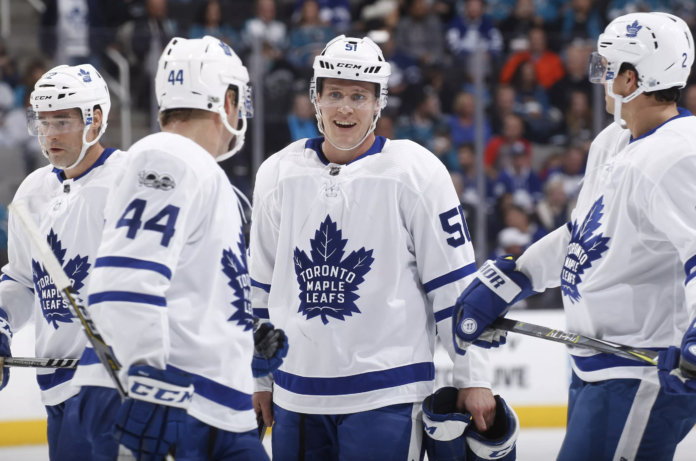
Earlier this week, reports from Pierre LeBrun and Elliotte Friedman suggested a small glimmer of hope in the form of possible common ground between Mitch Marner and the Toronto Maple Leafs in contract negotiations — at least as it pertains to the term of the contract, with both sides open to a three-year framework for Marner’s second NHL deal.
However, LeBrun later added that the two sides are still a ways apart on money, while Friedman hinted as recently as Friday that the two sides still aren’t particularly close to a final agreement.
For Leafs fans everywhere, that “here we go again” feeling is officially setting in — the difference being the stakes are even higher this time around.
From the Leafs’ side of it, the three-year number is potentially palatable for a number of reasons: A) Marner would be playing for the Leafs this year, firstly; B) It keeps him under RFA control for his third contract while punting the next negotiation three years down the road as opposed to one or two, C) They can get Marner signed under $10 million AAV until 2023 at this term.
From the Marner camp’s side of it, though, you have to wonder if their interest in the three-year term is contingent on a big third-year salary figure, similar to Timo Meier’s fourth-year salary number with the Sharks ($10 million in Meier’s case).
If that’s the case, and Friedman suggested as much on Friday, a big third-year salary ask would enable him to accept a large one-year qualifying offer in 2023, effectively bridging him to UFA and making it a potential four-year deal (in effect). That’s an absolute no-go for the Leafs; it buys zero UFA seasons and potentially bridges him to the open market all while paying what is objectively a premium price in the neighbourhood of $9.5 million AAV.
And if that’s the sticking point, how close are the two sides, really?
Not very, is the latest word from both Friedman and James Mirtle in their recent radio spots. Friedman suggested yesterday that the Leafs might go as high as $11 million on a seven-year deal, but it doesn’t sound like Marner is prepared to sell three UFA seasons at that rate at this point in time. This again reaffirms what’s been clear all along: The Auston Matthews contract (five years, $11.6 million AAV) is the anchor in this negotiation.
In his sitdown with Bob McKenzie, Kyle Dubas gently and accurately explained that goal-scoring centers of Matthews’ ilk have their own unique set of leverages in contract negotiations, but it seems clear at this point that this market reality is lost on the Marner camp. It’s not that they’re totally without an argument here — he’s been healthier than Matthews, plays all situations, has played plenty of minutes in top matchup situations, and outproduced Matthews in total points the past two seasons — but it’s not a winning one, objectively speaking.
Despite missing 34 games due to injury, Matthews leads the league in even-strength goal scoring since he broke the league in 2016. It’s obvious to anyone that follows the league that goal scoring is valued at a premium and that center ice is a premium position. This is not intended to dismiss the value of Marner’s production and versatility, but if you’ve never broken 30 goals and you’re playing on the wing, you’re not making Matthews money — it shouldn’t really be up for debate.
The scary thought is this if you’re the Leafs: It’s true Nylander spoke candidly on his regrets about jumping back into the fold in early December after his contractual holdout last season (Auston Matthews also warned against a player going this route just the other day on Tim&Sid. Players in a similar boat around the league surely took note of a player as skilled and well-conditioned as Nylander struggling as much as he did last year). But if the Marner camp is delusional enough to believe they’re deserving of the Matthews contract — or just shy of it — could they also believe that Marner is an exception who can jump back in partway through the season without much worry?
And then you’ve got the cap ramifications to consider. Dubas has admitted it would make cap manager Brandon Pridham’s life more difficult the longer this ordeal stretches into the season — a ballooning year-one cap hit while the Leafs are capped out and planning to eat into LTIR relief could create headaches for the club. The Clarkson trade prepared the Leafs’ cap books for Marner as a ‘maybe’ for opening night; they can build a roster as close to the cap ceiling as possible, thus banking very little cap space and opening as much LTIR room as possible for when he does arrive, be it through signing on the dotted line with the Leafs or in the outside possibility that the Leafs have to match an offer sheet. But the Leafs are pushed more and more against the wall the longer this stretches into the Fall.
Dubas, for his part, is still playing nice. He is frustrated, but he’s not negotiating publicly and he’s ruled out exploring a trade market for the player. To pretend this is just like all of the other situations in the league is a case of “yeah, but…” The Leafs, unlike many teams and players in this situation, are not standing around waiting for one of the marquee names to come off the board. That’s partly because Marner is in competition with Brayden Point and Mikko Rantanen for the top of the 2019 RFA class, but it’s more that the Leafs are a Cup-contending team in a cap bind with a clear sense of urgency to their situation dating back to late June. They’ve also been through this ordeal just a year before and saw how this impacted the player and the team’s season (Nylander played pretty well in the Boston series, for my money, but is a fully confident Nylander the difference in a tight seven-game contest?).
What makes this whole negotiation much more frustrating than the Nylander one a year ago: In listening to Dubas reflect on the Nylander negotiation, it’s clear he thought the team started the process too late. Dubas also felt he made a mistake in letting the negotiations go cold over long stretches of time with no contact between the two sides. By contrast, the earliest stages of this Marner negotiation date back to May of 2018 and, by all accounts, the two sides have been in regular contact all summer. And yet here we are.
On top of that, the Leafs are making better-than-reasonable offers and Dubas also appears not to be overly rigid in how this contract needs to be structured. Many eyebrows were raised throughout the league when Dubas set a fresh precedent by handing Auston Matthews a player-friendly five-year contract, one that bought just one UFA season while paying the star center $11.6 million in average annual salary. Dubas — and John Chayka is operating in a similar vein with his recent player contracts in Arizona — clearly does not care how his approach is perceived around the league. He has also been up front about his willingness to bite the bullet with borderline overpayments (based on historical comparables) for his star core players, putting the burden on himself to make it all work with efficient managerial maneuvering on the edges of the roster. And yet here we are.
While it was clear as Marner piled up points throughout the 2018-19 season that this negotiation was going to present a new challenge from the Nylander situation last year, a few common threads remain: Dubas is not willing to play hardball or negotiate through the media. He is not exploring trades to test the other side’s bluff, nor is he pretending that he might publicly. And he is also not going to contribute in any way to the poisoning of the player’s reputation within the market (and that’s probably the right way to handle a player and personality of Marner’s ilk if you want to achieve Dubas’ stated long-term goal of making #16 a career Leaf).
This also means that the only pressure point on Marner’s side of this comes down to the player’s appetite to sit out of camp and miss hockey games. When will Marner do as Nylander did at the final hour on December 1st of 2018 — i.e. take the wheel out of his agent’s hands in order to push a deal over the line? Or is it Dubas and the Leafs that will flinch first?
Ultimately, it’s a game of chicken. As we learned from Nylander’s situation last year, at least as far as the upcoming season goes, it’s one that can easily result in a lose-lose outcome.
Jake Gardiner signs in Carolina
Am I alone in thinking the Leafs’ appetite for bringing Jake Gardiner back might not have been as strong as was reported in the media?
What Gardiner just signed for in Carolina — four years, a shade over $4 million AAV — amounts to a steal for a prime-aged defenseman who can deliver the even-strength production and puck-moving abilities Gardiner brings to the ice. The Leafs don’t have any certainty on the Marner situation as of early September, but it’s a little bizarre to think the team could’ve kept Gardiner in place of Cody Ceci and actually saved nearly $500k in cap space in 2019-20. Plus, if reports of Gardiner’s deep desire to return to Toronto were true, you wonder if the Leafs could’ve brought Gardiner back at a little less money or a little less term than he signed for in Carolina.
And it might’ve been feasible if the Leafs had taken a different route with Ceci. The player had a qualifying offer in hand when the Leafs signed him to his current one-year, $4.5 million number, but if he opted for arbitration, the Leafs likely would’ve been presented with a walk-away opportunity after the settlement (granted, it was not a guarantee he would have elected for arbitration with the QO in hand).
Alternatively, the Leafs could’ve loaded Ceci’s contract with up-front bonuses before flipping him for peanuts to a non-cap team. Surely, there would’ve been some interest in a cheap one-year flyer on a relatively young, right-handed reclamation project. Instead, they gave Ceci a one-year deal with his $4.5 million all paid out in base salary.
Is it simply that the Leafs see potential value in Ceci once he’s partnered with Morgan Rielly or Jake Muzzin (major upgrades over his playing partners in Ottawa, to be sure)? Was it that combined with the need for a serviceable RHD, with the sense that neither Gardiner or Rielly could play their off side (Travis Dermott, once healthy, looks like he could, and we’ve yet to see Muzzin tried there)? Were the Leafs quietly thinking Gardiner needed a fresh start after two difficult playoff series in a row versus Boston — which were hard on him personally? Were they worried about committing to Gardiner with the question marks surrounding his back?
I guess we’ll never know. In any event, best of luck to Jake in Carolina.
































